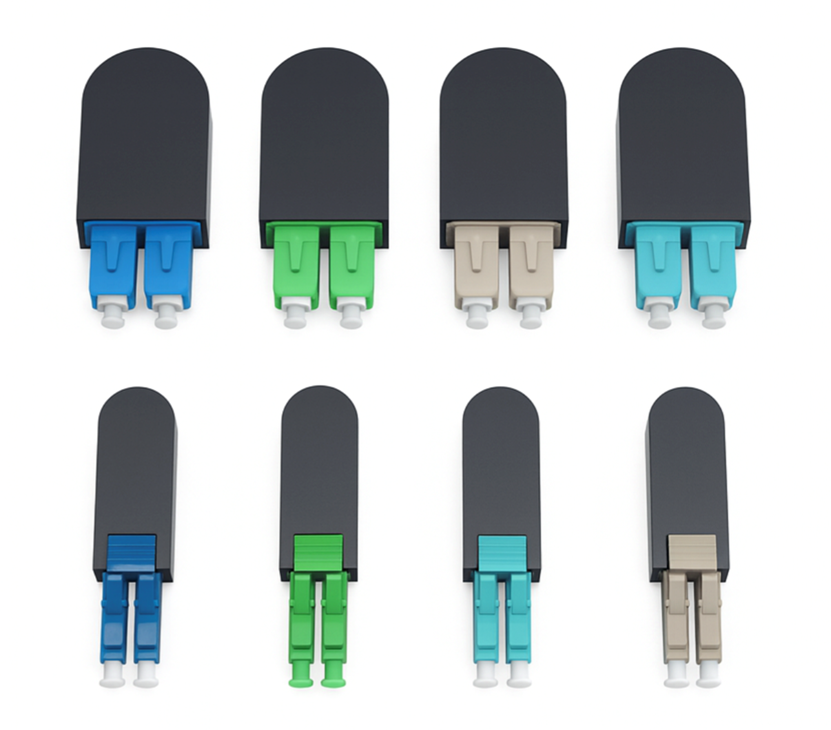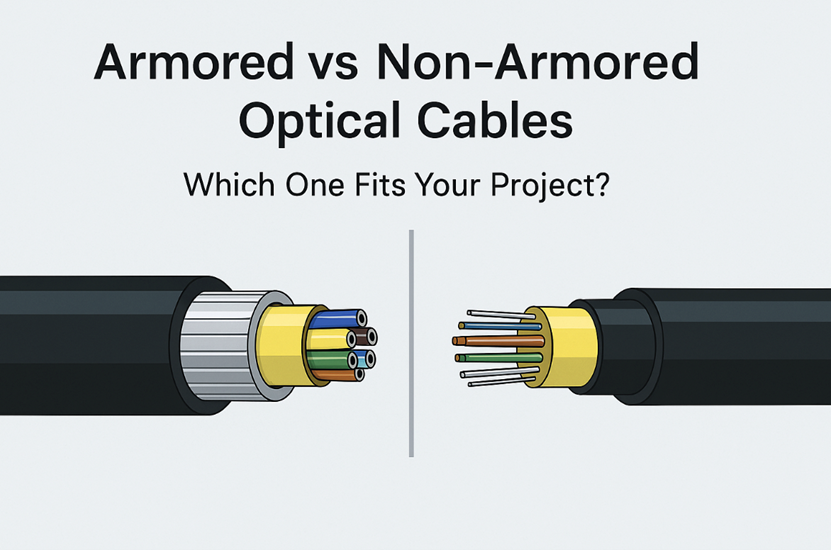5G technology offers ultra-fast speeds, low latency, and high bandwidth capacity, making it essential for various applications such as smart cities, autonomous vehicles, Internet of Things (IoT), and remote healthcare. However, the deployment of 5G infrastructure requires a robust fiber optic network to support the massive data demands and ensure seamless communication between devices and networks.
One of the key components of this fiber optic infrastructure is armored fiber optic cables. These cables provide an added layer of protection and durability, ensuring that the network remains secure and operational even in harsh or high-risk environments.
Understanding Armored Fiber Optic Cables
Armored fiber optic cables are designed to provide extra protection to the delicate fiber optics inside. These cables consist of a standard fiber optic core, which is responsible for transmitting data, surrounded by a protective layer or armor. The armor is typically made of materials such as steel or aluminum, providing resistance against physical damage, environmental hazards, and even potential security threats.
Armored fiber optic cables are available in various configurations, including:
① Single armor: A single layer of armor around the fiber optic core.
② Double armor: Two layers of protective armor for additional durability and protection.
③ Indoor/outdoor armored cables: Designed to withstand both indoor and outdoor environments, providing flexibility in installation and use.
The Challenges of 5G Network Deployments in Harsh Environments
As 5G networks expand across the globe, they are being deployed in a wide range of environments, from dense urban areas to remote, rural locations. Each of these environments presents its own set of challenges that can impact the performance and security of the network. Below are some of the key challenges that armored fiber optic cables can help address in securing 5G network deployments.
1. Physical Damage and Environmental Hazards
Fiber optic cables, while highly efficient in transmitting data over long distances, are delicate and vulnerable to damage from physical forces. In harsh environments, such as industrial areas, construction zones, or remote terrains, fiber optic cables may be exposed to crushing forces, impacts, or even accidental cutting during excavation or installation.
Environmental factors such as extreme temperatures, humidity, and UV radiation can also degrade fiber optic cables over time, leading to performance issues or complete network failure. Additionally, outdoor installations in areas prone to flooding, wildfires, or earthquakes pose significant risks to the integrity of fiber optic cables.
Armored fiber optic cables offer superior protection against these physical and environmental hazards. The armor shields the fiber optic core from impact, crushing, and bending forces, ensuring that the network remains operational even in extreme conditions. The rugged design of armored cables allows them to withstand outdoor elements, reducing the risk of cable failure due to environmental stressors.
2. Security Threats and Network Vulnerability
As the backbone of 5G networks, fiber optic cables are crucial for maintaining the flow of data and communication between devices, base stations, and core network infrastructure. This makes them a potential target for tampering, vandalism, or theft. In high-risk environments such as urban areas or locations near critical infrastructure, fiber optic cables may be vulnerable to intentional damage or unauthorized access.
For example, individuals may attempt to physically tap into fiber optic cables to intercept sensitive data or disrupt network services. This can have severe consequences for network security, especially in government, military, or financial sectors, where secure data transmission is essential.
Armored fiber optic cables provide an added layer of security against such threats. The durable armor makes it more difficult for unauthorized individuals to access the fiber core, reducing the likelihood of data interception or network disruption. Additionally, armored cables are less likely to be damaged during attempts at vandalism or theft, ensuring the continuous operation of the 5G network in high-risk areas.
3. Harsh Installation Conditions
In many cases, the installation of 5G networks requires fiber optic cables to be deployed in challenging environments such as underground conduits, subsea installations, or aerial cable routes. These environments pose unique challenges for network installation and maintenance, as fiber optic cables may be subjected to extreme tension, abrasion, or mechanical stress during installation.

Underground installations, in particular, are at risk of being disturbed by heavy machinery, rodents, or natural shifts in the terrain. In subsea installations, fiber optic cables must withstand the pressure of the water and potential damage from marine life or anchors. Aerial cables, on the other hand, are exposed to wind, rain, and ice, which can weaken the cable over time.
The armor in armored fiber optic cables serves as a protective barrier during installation in these harsh environments. It prevents the cable from being damaged by pulling forces or abrasions as it is laid in underground ducts or submerged in water. This ensures that the network can be installed without compromising the integrity of the fiber optics, reducing the likelihood of network downtime or the need for costly repairs.
4. Maintaining Network Reliability in Remote Areas
In rural or remote areas where 5G networks are being deployed, maintaining network reliability can be challenging due to the lack of infrastructure and support. These areas may be prone to wildlife interference, harsh weather conditions, and limited access for maintenance crews. Fiber optic cables in such environments must be able to withstand long periods without physical inspection or repair.
Armored fiber optic cables are ideal for these remote installations, as they are designed to provide long-term durability and protection. The armor shields the fiber core from potential damage caused by wildlife, such as rodents chewing through cables, or from extreme weather events that could weaken traditional cables. By using armored cables, network operators can ensure that 5G services remain reliable and operational even in areas with limited infrastructure and maintenance resources.
Key Benefits of Using Armored Fiber Optic Cables in 5G Networks
Now that we have discussed the challenges of deploying 5G networks in harsh environments, let’s explore the key benefits of using armored fiber optic cables to enhance network security and reliability.
1. Enhanced Physical Protection
The primary benefit of armored fiber optic cables is their enhanced physical protection. The armor provides a robust defense against crushing, impacts, and bending forces that could damage traditional fiber optic cables. This is particularly important in environments where cables are exposed to heavy machinery, construction activities, or natural disasters.
By using armored cables, network operators can significantly reduce the risk of physical damage to the fiber optics, ensuring that the network remains operational even in the most demanding conditions.
2. Increased Durability and Longevity
Armored fiber optic cables are designed to withstand harsh environmental conditions, making them ideal for outdoor and remote installations. The armor protects the fiber optics from moisture, UV radiation, and temperature fluctuations, all of which can degrade the performance of standard cables over time.

In addition, armored cables are resistant to abrasion, rodent damage, and corrosion, ensuring that they can maintain their performance and reliability for years without requiring frequent maintenance or replacement. This increased durability translates to lower operational costs and reduced downtime for network operators.
3. Improved Security Against Tampering and Vandalism
Armored fiber optic cables provide an added layer of security against tampering, vandalism, and theft. The durable armor makes it more difficult for unauthorized individuals to access the fiber core, reducing the likelihood of data breaches or network disruptions.
In high-risk areas, such as urban centers or critical infrastructure locations, the use of armored cables helps to protect the network from potential security threats, ensuring that sensitive data is transmitted securely across the network.
4. Reduced Maintenance and Downtime
By providing enhanced protection and durability, armored fiber optic cables help reduce the need for frequent maintenance and repairs. In harsh environments where cable damage is more likely, the use of armored cables can prevent costly network outages and minimize the time required for maintenance crews to address issues.
This is especially important in remote areas where access to the network may be limited, as armored cables can continue to perform reliably without constant physical inspection or intervention.
5. Support for Long-Term 5G Network Expansion
As 5G networks continue to expand, using armored fiber optic cables ensures that the infrastructure can support long-term growth and scalability. The durability and reliability of armored cables make them ideal for supporting the high-speed, high-capacity demands of 5G technology, ensuring that the network remains robust and secure as more devices and users come online.
Choosing the Right Armored Fiber Optic Cables for 5G Deployments
Selecting the right armored fiber optic cables is crucial for ensuring the success of 5G network deployments, especially in harsh or high-risk environments. Below are some key factors to consider when choosing armored cables for your 5G infrastructure:
1. Type of Armor (Single vs. Double)
The type of armor used in the cable will depend on the protection required for the specific deployment environment. Single-armored cables are suitable for most outdoor installations, while double-armored cables provide additional protection for more extreme environments.

2. Cable Jacket Material
The outer jacket of the armored cable should be made of materials that are resistant to environmental hazards such as UV radiation, moisture, and chemicals. Look for cables with durable polyethylene (PE) or PVC jackets for outdoor installations.
3. Fiber Count and Configuration
Choose cables with the appropriate fiber count and configuration to support the bandwidth and scalability needs of your 5G network. High-fiber-count cables may be required for densely populated areas or locations with high data traffic.
4. Compliance with Industry Standards
Ensure that the armored fiber optic cables you select comply with industry standards for performance, durability, and safety. Look for cables that are certified by organizations such as the Telecommunications Industry Association (TIA) or the International Electrotechnical Commission (IEC).
Conclusion
As 5G networks continue to revolutionize the way we connect and communicate, ensuring the security and reliability of the network infrastructure is paramount. Armored fiber optic cables play a critical role in protecting 5G networks from physical damage, environmental hazards, and security threats, especially in high-risk or harsh environments.
By providing enhanced durability, protection, and security, armored cables help to ensure that 5G networks can meet the growing demands of modern communication and data transfer. Whether in urban centers, rural areas, or remote installations, the use of armored fiber optic cables is essential for securing the future of 5G connectivity.








